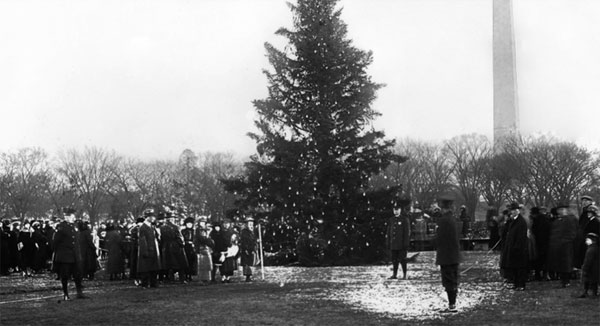The large evergreen tree that is located near the White House in Washington, D.C. has been decorated each year since 1923. But did you know on this 6th day of December, in 1970, a coastal storm over the eastern U.S. produced high winds which toppled the national Christmas tree?
The 78-foot tall blue spruce from South Dakota’s Black Hills was carried to Washington, D.C. on a train. While en route, the train derailed twice. Then the weekend before the tree lightning ceremony, on December 6th, the tree blew over in high winds and several cut branches had to be attached to the tree to replace damaged ones.
A few days after the tree was lit, light bulbs on the lower half of the tree began exploding after a fireproofing liquid applied to the sockets began causing shorts in the strings of lights.
In 1973, the Christmas pageant of Peace introduced a living tree, a 42-foot Colorado blue spruce from the Sunset Lake Nursery near Shickshinny, Pennsylvania, which was donated by the National Arborist Association.
The 1970 Christmas tree wasn’t the only tree to be affected by the weather. In December 1976, it was clear that the National Christmas tree was dying. A new tree was planted in 1977, before being toppled by 62-mph winds on January 26th, 1978.
A third tree, donated from York, Pennsylvania, was planted in 1978, with a second tree purchased as a spare in case the new transplanted tree did not survive. New, stronger cables were used to help brace the tree against high winds. This tree would end up being the longest-serving tree in national Christmas tree history. But just like the previous trees, this tree would also toppled in a wind storm on February 19th, 2011, as gusts up to 50-mph snapped the trunk.
Knowing the tree was at risk, a successor tree had already been selected and was planted on March 19th, 2011. Nearly a year later, on May 5th, 2012, the blue spruce was declared dead by the National Park Service due to transplant shock, after an exceptionally warm and dry Spring.
The current tree, was planted on October 27th, 2012. The Park Service decided to plant the tree, even though Hurricane Sandy would pass near the D.C. area in less than 48 hours. Horticulturists felt the tree was safer in the ground, than in the container it was shipped in. Wires were attached to the tree to help stabilize it, and a special base surrounded the roots to help prevent flooding.
-Story Image: National Park Foundation
